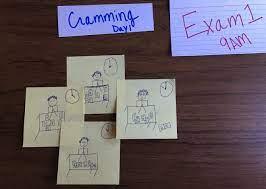Get More Out of Your Study Sessions
- Break up your study sessions rather than try to cram it all in the night before the test. By studying information in increments, you will be more likely to remember it until test day.
- If you are struggling to memorize something important, momentary interruptions might actually work to your advantage. While you are focusing on other things, you will find yourself mentally returning to the information you were studying.
710
1.29K reads
The idea is part of this collection:
Learn more about personaldevelopment with this collection
How to manage anxiety and self-doubt
Strategies for setting realistic goals
The importance of self-compassion and self-care
Related collections
Similar ideas to Get More Out of Your Study Sessions
Space out your study sessions
It’s better to distribute the time you have available to study over a greater number of shorter sessions than it is to cram your studying into a single marathon session.
If you have 12 hours to dedicate to a topic, it’s better to study over six two-hour-long sessions th...
Divide up + space out study sessions.
When studying for an exam, it’s easy to get overwhelmed by the sheer amount of information to learn. Most of the stress associated with studying is a result of poor planning and time management that leads to stressful cramming the night before.
Research has shown that dividing your study in...
9. Get Out Of Your Head
Next time you’re having a conversation, see if you catch yourself thinking about what you’re going to say next rather than focusing on what the other person is saying. You may be surprised how often it happens.
Generally, being aware of this tendency is enough to improve it. But if you’re s...
Read & Learn
20x Faster
without
deepstash
with
deepstash
with
deepstash
Personalized microlearning
—
100+ Learning Journeys
—
Access to 200,000+ ideas
—
Access to the mobile app
—
Unlimited idea saving
—
—
Unlimited history
—
—
Unlimited listening to ideas
—
—
Downloading & offline access
—
—
Supercharge your mind with one idea per day
Enter your email and spend 1 minute every day to learn something new.
I agree to receive email updates
